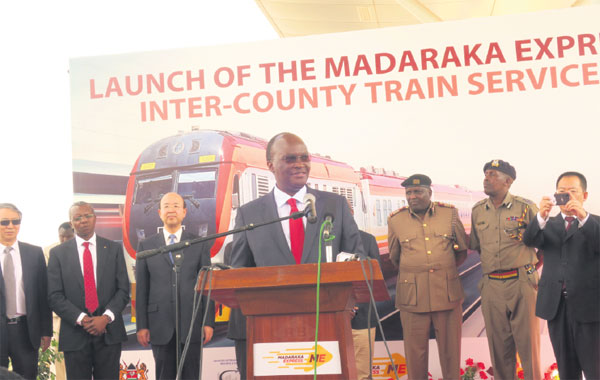Railway boosting Kenya's tourism sector
Kenya's economy is starting to experience the benefits of its Chinese-backed modern rail infrastructure, with more locals flocking to the coastal city of Mombasa over the past five months, boosting domestic tourism.
The Madaraka Express has transported more than 420,000 passengers - an average of 2,750 per day at an occupation rate of 92 percent - between Nairobi and the port city, boosting bed occupancy in June and August to 80 percent. That is up from 50 percent in previous years, the government says.
|
James Macharia, cabinet secretary of transport, infrastructure, housing and urban development, says the new service will open up tourism destinations along the Mombasa-Nairobi route that were not previously accessible. [Photo/China Daily] |
It is expected that with the launch of a second train service, numbers will go even higher, giving a boost to the sector that has been struggling to prop up the number of domestic visitors compared with international arrivals. Kenya Railways, the agency regulating the sector, launched the inter-county train service on Nov. 1.
According to James Macharia, the cabinet secretary for transportion, infrastructure, housing and urban development, the train will stop at seven stations: Athi River, Emali, Kibwezi, Mtito Andei, Voi, Miasenyi and Mariakani.
Those traveling from Nairobi to Athi River will pay less than US$1, while those traveling to Mtito Andei will pay less than US$4, compared with US$5 for buses.
"Over time, we have introduced a number of initiatives that we hope have made your Madaraka experience better. We have introduced various ticket booking platforms, meaning you no longer have to physically visit the station to purchase your tickets. We expanded the window for booking," says Macharia.
He says the core aim of the railway is to lower transportation costs and make it affordable for Kenyans to travel for business and leisure. Macharia also says the government is rolling out freight service, which is expected to lower the cost of cargo transportation between Mombasa by up to 35 percent and Nairobi's container depot.
He adds that testing of the commercial cargo system is set to begin this month, with freight operations expected to start next year.
Paul Maringa, Kenya's principal secretary for transportation, says the introduction of the additional train will increase passenger numbers, enable more movement of locals and tourists, and further boost opportunities for businesspeople who need to travel within short periods.
He says the standard gauge railway has already begun to have an impact.
"The services are offering a solution to traffic congestion, the wear and tear experienced on our roads and will ultimately decongest the Mombasa-Nairobi road, which is synonymous with traffic snarl-ups," he says.
Chinese Ambassador to Kenya Liu Xianfa says the railway has facilitated the development of the East African country and the realization of Vision 2030, the country's development blueprint.
"It is endowed with the significant role of speeding up the industrialization process of Kenya and the region and promoting the integration of the Belt and Road Initiative with the development strategies of African countries," Liu says.
Li Quanhuai, vice-president and chairman of China Road and Bridge Corp, which operates the railway, says:
"The successful launch of the inter-county passenger train will not only provide more choices for passengers in terms of time and destinations, but also reinforce the population and commodities circulation along the railway as a key driver for the Kenyan economy."
